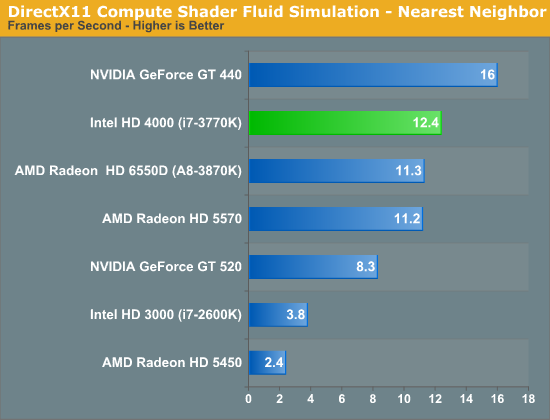The Ivy Bridge Preview: Core i7 3770K Tested
by Anand Lal Shimpi on March 6, 2012 8:16 PM EST- Posted in
- CPUs
- Intel
- Core i7
- Ivy Bridge
Anisotropic Filtering Quality
At IDF last year Intel promised an improvement in its anisotropic filtering quality compared to Sandy Bridge. Personally I didn't believe SNB's GPU was fast enough to warrant turning on AF in most modern titles, but as Intel's GPU performance improves it must take image quality more seriously.
I wouldn't put a ton of faith in these early results as things can change, but AF quality does appear to be much better than Sandy Bridge:

The peculiar radial lines that were present in SNB's algorithm remain here, although they are more muted. Again it's too early to tell if we're looking at final image quality or something that will improve over time. If we are to judge based on this result alone, I'd say it mirrors what we saw in our performance investigation: Ivy is a step towards AMD in the GPU department, but not a step ahead.
DirectX 11 Compute Performance
As Ivy Bridge is Intel's first DirectX 11 GPU architecture, we're actually able to run some DX11 workloads on it without having them fall back to DX10. We'll do a much more significant investigation into GPU compute performance in our full Ivy Bridge review, but as a teaser we've got our standard DirectX 11 Compute Shader Fluid Simulation test from the DX11 SDK:

Ivy Bridge does extremely well here, likely due in no small part to its excellent last level cache. The Fluid Simulation we run looks at shared memory performance, which allows Ivy to do quite well. We're seeing over 3.2x the performance of Sandy Bridge here, and even a slight advantage over Llano.










195 Comments
View All Comments
arno - Friday, March 9, 2012 - link
No, it is just out of question for me to overclock. I wanna buy a profesional laptop (w520 lenovo). SO no way to teak it.Fact is memory will be 1600 Mhz and the processor a bit stronger with maybe a better memory controler.
At one month of the release, it worth to wait it.
Just wanna make sure that in my particular case it really worth it cause i'm tired of my heavy old laptop. I buy this damn machine just for working after all. At home, my E8400 is still upto date for what I do with it.
DDR4 - Friday, March 9, 2012 - link
I want to see some increase in performance and actual processing power. For now, i can leave the graphics to the GPU.Nexing - Friday, March 9, 2012 - link
@ArnoI'd consider a few aspects:
-Do you need to use precision external gear, -like we audio people do with soundcards- and hence need ExpressCard or Thunderbolt connectors? Then I'd expect May-Jun launches will bring those professional Laptops and Ultrabooks.
-If portability is important, factual Sandy bridge battery capacity is near 4 hours whether Ivy Bridge battery will extend real usage around eight hours for similar performance.
-Furthermore USB 3.0 will be native, something important since most renesas boards have been far from perfect and just their recent (Feb/March 2012) releases seem to finally have nailed efficiency.. Problems with USB 3.0 equiped Sandy Bridge laptops abound in forums, and that is in professional brands.
-If you were questioning about SandyB vs IvyB desktops, you could still buy now the former and later upgrade for the later CPU, but with the mobile platform, Intel has stated that H67M -their actual chipsett platform, also named Cougar Point- Upgradeability is not going to be feasible, despíte it could be technically possible easily..
Therefore, there a many reasons pointing to wait. Since sales are very low, any are choosing this route.
arno - Saturday, March 10, 2012 - link
Thanks Nexing for u answer. Actually, i totally agree with you on:portability => IB is a shrink and must be more power efficient for an equivalent task load. Seems that the test proves it. moreover, I will work a lot in trains or outdoors (visiting customers), so it is definitely a +.
USB 3 => u feedback is very interesting. I myself think that "native" versus "add on" USB3 feature must be better. And that was also a reason for me to wait when last december, i was already thinking of buying something new. Now i'm quite sure that it was the good thing to do.
For the rest, more than external gears, I need a processor good in floating points calculation. I do intensive electrical simulations so i definitely need it.
I took my decision and I will wait. This laptop will replace and desktop and laptop for work (and work only cause for internet or usual offices task, i definitely think a core 2 duo can make it); so better to catch the best. I will manage the present emergency I have, praying for Lenovo (or Samsung?) to offer new Ivy Bridge laptop as soon as possible. Let's make a bet: Lenovo got it ready to release and is just waiting for the official launch date....
thanks for sharing ;)
Nexing - Friday, March 9, 2012 - link
Should say:"many are taking this waiting route"
arno - Saturday, March 10, 2012 - link
"FP/integer divider delivers 2x throughput compared to Sandy Bridge"I should read more carefully. That is an answer to my question. Maybe not a spectacular improvement, but still one.
DrWattsOn - Tuesday, March 13, 2012 - link
@arno I'm GLAD you didn't read more carefully, because you posted the question, and Nexing's answer focused me on something I still wasn't considering as a major factor in my decision: USB3. Between your question and the response, I also got a better picture of how specific use is affected by the tech. So, I'm a waiter (tho I don't serve food 8^D ).stephenbrooks - Saturday, March 10, 2012 - link
Intel released on 2006, 2007, 2008, 2010, 2011, 2012.In base 9 they're on schedule.
bhima - Saturday, March 10, 2012 - link
Basically every 2D-based graphic designer/web designer doesn't need a discrete GPU for their work. The IGPs handle that workload fine (mainly because most of the processing needed for photoshop, indesign, illustrator or dreamweaver is CPU based). A discrete GPU gives you better performance with the very limited 3D stuff that photoshop offers which is situational at best for the vast majority of graphic designers.3D artists and those that pump a ton of effects in video editing, they would benefit from discrete.
shadow king - Monday, March 12, 2012 - link
^ =)